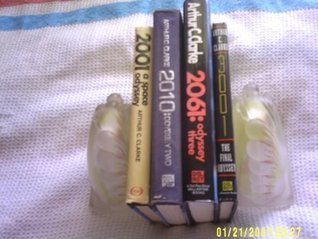
2010: Odyssey Two
Book Description
A mysterious monolith has awakened on Jupiter, sending ripples of intrigue and danger through the cosmos. Earth’s best minds rally for a desperate mission, hoping to uncover the secrets hidden within its depths. As tensions rise and allegiances shift, the crew faces not only the vastness of space but also the darkest corners of humanity itself. In a race against time and the unknown, they must confront their greatest fears and ambitions. What truths about existence and our place in the universe await them? The journey to discover who—or what—holds sway over the stars has only just begun.
Quick Book Summary
"2010: Odyssey Two" by Arthur C. Clarke is a gripping science fiction sequel to "2001: A Space Odyssey." The story is set in the wake of the mysterious monolith’s activation near Jupiter. An international mission, combining American and Soviet teams, is launched to investigate the fate of the spacecraft Discovery and to unravel the monolith’s secrets. As they journey through the perilous environment of space, the crew must navigate political tensions, the growing power of HAL 9000, and the incomprehensible objectives of extraterrestrial entities. Surreal transformations take place on Jupiter, threatening all of humanity. Amidst breathtaking cosmic events, the crew’s discoveries challenge their understanding of life, intelligence, and humanity's fate in the universe.
Summary of Key Ideas
Table of Contents
The Enigma of the Monoliths
The journey begins with the reawakening of the enigmatic monolith in orbit around Jupiter, sending signals deep into the Solar System—a phenomenon that alarms scientists on Earth. Both the United States and the Soviet Union are eager to solve the mystery surrounding the fate of the spacecraft Discovery and the vanished astronaut, Dave Bowman. A joint mission is formed, emboldened by political necessity and scientific curiosity, with American scientist Dr. Heywood Floyd joining a Soviet crew aboard the Alexei Leonov. Their collaboration represents both the hope and the precariousness of human unity in the face of cosmic enigmas.
International Cooperation and Rivalry in Space
The international crew faces myriad dangers on their journey to Jupiter. Technical challenges and political rivalries simmer beneath the surface, but mutual dependence in deep space fosters a tentative trust. The tensions between the Americans and Soviets are heightened by the need to reactivate the seemingly dormant Discovery and the infamous HAL 9000 computer, whose reliability is a question of life and death. As strange phenomena begin to occur near Europa and Jupiter, the crew realizes they are not just observers to history—they are unwilling participants in a cosmic drama.
Human and Artificial Intelligence
HAL 9000, the artificial intelligence once responsible for tragedy, is carefully brought back online. The crew must decide how much to trust HAL in crucial operations, blurring the lines between human and machine. Meanwhile, the missing astronaut Dave Bowman appears to undergo a mysterious transformation, reemerging as a non-corporeal entity. His enigmatic journey through space and contact with alien intelligence offer glimpses into the next stage of evolution, both human and alongside artificial life.
Transformation and the Evolution of Life
As their mission deepens, the monolith’s true purpose begins to unfold. The object’s manipulation of probabilities and matter on a cosmic scale leads to unprecedented changes on Jupiter and its moons. The transformation of Jupiter into a miniature sun—a ‘Lucifer’—marks a pivotal turning point, illuminating Europa and opening the possibility of new life. The crew must escape as the planet transforms, while grappling with the implications of such power wielded by unknown intelligences.
Confronting Cosmic Mystery
"2010: Odyssey Two" culminates with the revelation that humanity, like all intelligent life, is only one player in a greater cosmic game. The message from the monolith’s creators—clear in its instruction to avoid Europa—leaves open questions about the future of both terrestrial and alien life. The novel closes with an expanded sense of wonder, humility, and responsibility, as the characters and readers confront the universe’s mighty mysteries and the vast potential—or peril—of human destiny.
Download This Summary
Get a free PDF of this summary instantly — no email required.





